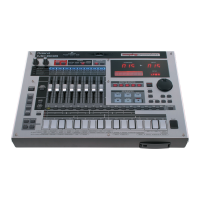28
Effects editing parameters
Compressor
Parameter
Range Explanation
Comp Reverb
Send Level
0–127 Depth of reverb applied to the
sound processed through the
compressor
Set this to 0 if you don’t
want to apply reverb.
Comp Output
Assign
DRY, MFX1,
MFX2
Output destination of the
sound processed through the
compressor
DRY:
MIX OUTPUT jacks
MFX1 (2):
Multi-effects 1
(or 2)
Attack Time 0.05–50 ms Time from when the volume
goes up the threshold level
until the compressor effect ap-
plies
Release Time 0.05–2000 ms Time from when the volume
falls below the threshold level
until the compressor effect no
longer applies
Threshold 0–127 Volume level at which com-
pression begins
Ratio 1:1–inf:1 Compression ratio (inf: infini-
ty)
Output Gain 0– +24 dB Level of the output sound
Low Freq 200, 400 Hz Reference frequency of the
low range
Low Gain -15– +15 Amount of low-range boost/
cut
High Freq 2k, 4k, 8kHz Reference frequency of the
high range
High Gain -15– +15 Amount of high-range boost/
cut
Level 0–127 Output volume of the com-
pressor
Multi-effects
Parameter Range Explanation
MFX Type 0–47 Effect used by multi-effect 1/2
* For details on each effect,
refer to “
Multi-Effects Pa-
rameters
(p. 29)”.
MFX1 (2) Re-
verb Send
Level
0–127 Depth of reverb applied to the
sound processed through
multi-effect 1 (2)
Set this to 0 if you don’t
want to apply reverb.
MFX1 Output
Assign
DRY, MFX2 Output destination of the
sound processed through
multi-effects 1
DRY:
MIX OUTPUT jacks
MFX2:
Multi-effects 2
(multi-effects 1 and 2 will be
connected in series)
* This parameter exists only
for MFX 1.
Reverb
Parameter
Range Explanation
Reverb Type
OFF, 1–4 Type of reverb
OFF:
Reverb not used
1 (REVERB):
Basic reverb
2 (SRV ROOM):
A more detailed
simulation of room reverberation
3 (SRV HALL):
A more detailed
simulation of hall reverberation
4 (SRV PLATE):
A simulation of a
plate echo (a reverb device using a
metal plate)
1 (REVERB)
Type
ROOM1,
ROOM2,
STAGE1,
STAGE2,
HALL1,
HALL2,
DELAY,
PAN-DE-
LAY
Type of reverb/delay
ROOM1:
Short, high-density re-
verberation
ROOM2:
Short, low-density rever-
beration
STAGE1:
A greater amount of late
reverberation
STAGE2:
Emphasis on early re-
flections
HALL1:
Clear reverberation
HALL2:
Rich reverberation
DELAY:
A conventional delay
PAN-DELAY:
A delay in which
the reflected sound moves be-
tween left and right
Time 0–127 Length of reverberation (Type:
ROOM1–HALL2)
Delay time
(Type: DELAY, PAN-DELAY)
HF Damp 200–8000
Hz, BY-
PASS
Frequency at which the high-fre-
quency portion of the reverbera-
tion will be cut (BYPASS: no cut)
Delay Feed-
back
0–127 Number of delay repetitions (valid
only if Type is DELAY or PAN-
DELAY)
Level 0–127 Volume of the reverb sound/de-
lay sound
2 (SRV ROOM) / 3 (SRV HALL) / 4 (SRV PLATE)
Pre Delay 0.0–100.0
ms
Delay time from original sound
until reverb is heard
Time 0–127 Length of reverb
Size 1–8 Size of room/hall
High Cut 160–12500
Hz, BY-
PASS
Frequency at which the high-fre-
quency portion of the final output
sound will be cut (BYPASS: no cut)
Density 0–127 Density of reverb
Diffusion 0–127 Change in reverb density over
time
Higher settings will cause den-
sity to increase as time passes.
(This is more noticeable with
longer Time settings.)
LF Damp
Freq
50–4000 Hz Frequency at which the low-fre-
quency portion of the reverb will
be cut
LF Damp
Gain
-36–0 dB Amount of attenuation for LF
Damp (0: no attenuation)
HF Damp
Freq
4000–12500
Hz
Frequency at which the high-fre-
quency portion of the reverb will
be cut
HF Damp
Gain
-36–0 dB Amount of attenuation for HF
Damp (0: no attenuation)
Level 0–127 Volume of the reverb sound
MC-808_Slist_e.book 28 ページ 2007年9月7日 金曜日 午前11時11分

